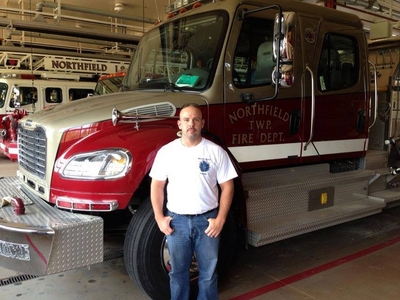Investigators find nothing wrong with plane involved in crash that killed Northfield Township firefighter

Northfield Township Firefighter Jamie Jose was killed in an airplane crash Friday. Investigators have determined nothing was wrong with the aircraft.
Courtesy of Northfield Township Fire Department
An investigation revealed that there were no mechanical problems with the plane that crashed Friday in Oakland County , killing a 34-year-old Northfield Township firefighter and three others, the Detroit News reports.
The National Transportation Safety Board determined the Cessna 172 being piloted by 19-year-old Troy Brothers wasn't malfunctioning, according to the Detroit News.
Brothers, his mother Sandra Haley, 53, stepfather James Haley, 58, and cousin, Jamie Jose, 34, were all killed in the crash, which occurred at 12:40 p.m. at Oakland County International Airport, the report said.
Jose had been a Northfield Township firefighter for about a year and a half and had recently moved near the fire station in Whitmore Lake, according to family members.
There will be a visitation for Jose at the Vermeulen Funeral Home, located at 46401 W. Ann Arbor Road, Plymouth Township, from 2 to 9 p.m. Friday. A memorial service will take place from noon to 1 p.m. Saturday at Dexter's St. Joseph Catholic Church, at 6805 Mast Road at the corner of North Territorial Road. A Mass of Christian burial will take place at 1 p.m.
A memorial scholarship fund also has been set up for Jose's children at the PNC Bank in Whitmore Lake. Call (734) 449-4477 for information about how to donate.
Read the Detroit News story.
John Counts covers cops and courts for AnnArbor.com. He can be reached at johncounts@annarbor.com or you can follow him on Twitter.


Comments
a2citizen
Wed, Jun 26, 2013 : 10:27 p.m.
Hoping those knowledgeable that comment on similar stories can provide some insight. How does a Cessna 172 with four adults and fully extended flaps become a little "too heavy"? The temperature was about 80 degrees.
michpilot
Wed, Jun 26, 2013 : 11:11 p.m.
Even though a Cessna 172 has 4 seats, it can typically only carry 4 adults if less than full fuel is carried because of weight restrictions. It just does not have enough power. Without looking at exact numbers, I would imagine there to be about 600 pounds available for passengers IF full fuel was carried. That means the average weight of the passengers would have had to be around 150 pounds. If a plane was overweight, it would have climbed significantly slower than the pilot anticipated, which would have been even worse with the high temperature. It also would stall at a higher speed and be harder to handle. The crash images are consistent with a stall. It is a possibility that the plane could have still flown, depending on how overweight it was, but the pilot might have been surprised by the slow climb rate. Flaps do two things - one is increase lift but the more flaps that are extended the more drag. If the pilot accidentally took off with full flaps, the amount of drag might have prevented climb. This is a possibility as it is a standard preflight procedure to extend the flaps to verify their operation and then retract them to less than full (sometimes 0) before takeoff. It is possible the extended flaps were the cause of the pilot thinking they were overweight, or the plane could have actually been overweight. That will be determined by the investigation. It's also possible the plane wasn't overweight at all, and the pilot (who had only had a license for a month) was surprised by significantly different handling near gross weight (the plane flies very differently and the climb rate would have been much less than the new pilot was used to). Unfortunately no training at max weight is required to get a license and this would be a very valuable skill. Regardless of what happened, this is a very sad story.
walker101
Wed, Jun 26, 2013 : 11:01 p.m.
There are four seats, two in the front and two in the back. However, unless the passengers are very light, you will be unable to carry four people and fuel. (And you really do want to carry fuel.) The useful load on a 172 will depend on the model year, engine power, and equipment installed. A typical range would be 800-1,000 pounds. You're not going to get far with less than 200 pounds of fuel, so that leaves 600-800 pounds (typically) for people and luggage. (With full fuel, remainig load can be as low as 450 pounds.) With high humidity and hot weather also play a factor, flaps down and a short take off will increase the chances of stalling depending on the climb rate. Most small planes have a checklist stating that you need to check your weight prior to departing.